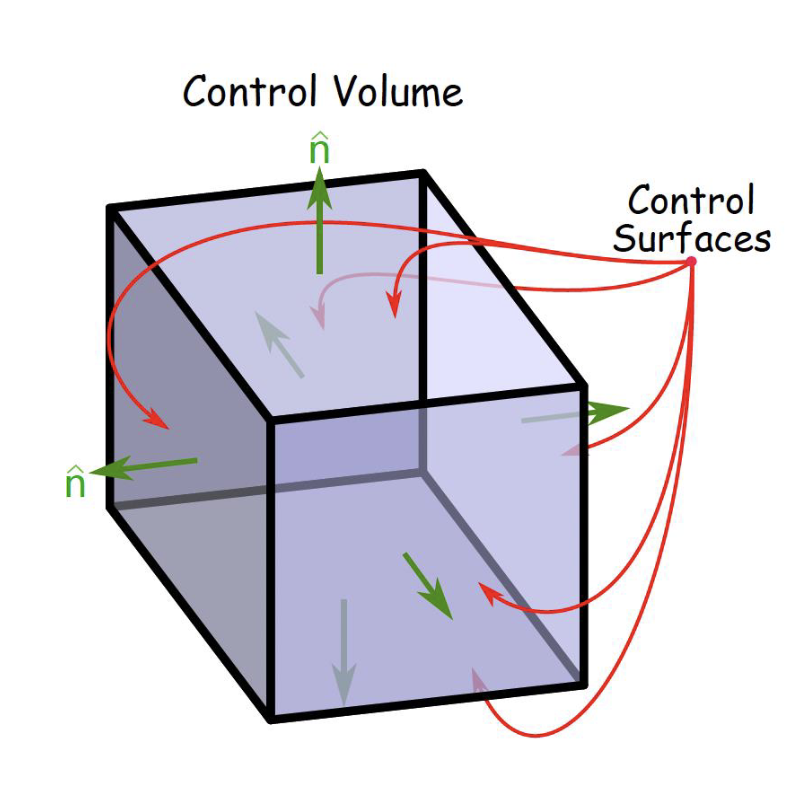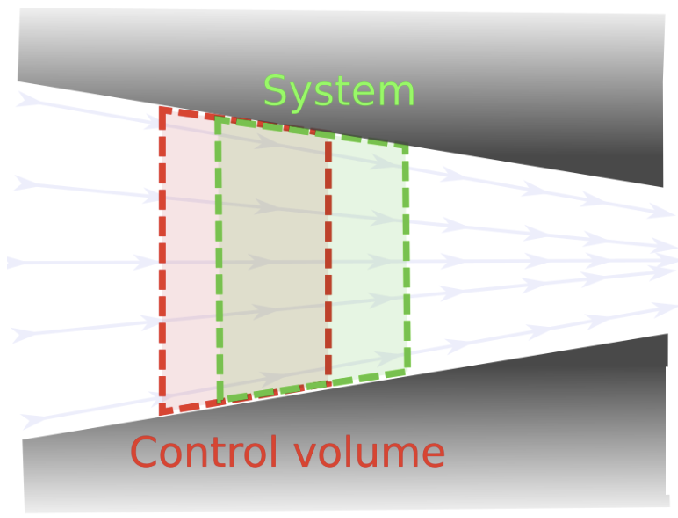What even is this?
- A clearly defined closed region in space
- Surfaces of a control volume are control surfaces
- Unit vector normal to control surface, n, is always directed outward
- We formulate equations as balance equations that apply over a given region of space or formulate equations (mass, momentum) that apply at each point in space
What is it actually
A control volume is a mental boundary that we define so that we can write conservation equations for mass and momentum, this is the same as defining our system in Thermodynamic Basics (Systems and Properties)
Why?
We use control volumes to look at conservations laws… The three ones related to fluid mechanics are…
- Conservation of mass
- Conservation of linear momentum
- Conservation of energy
This is intuitive for a system with many components

Differential form of conservation laws
- when p is const
We can use the idea of control volumes kind of like how we interact with circuits
How to choose the control volume
- It should contain the region of interest
- Boundaries should be placed where the information is known
- It can be of arbitrary shape
- It can move or deform
- In ME351, our control volumes will be fixed in shape and stationary or moving at a constant velocity
For Generic Control Volumes
- Only normal components contribute to an inflow or an outflow
Processes Associated with a Control Volume
- Storage or accumulation
- Inflow / outflow across control surfaces
How Do we Actually Obtain a Conservation Equation?
Storage
- RoC of mass in control volume ()
- Flow
- In flow and outflow through out control surfaces
- Putting it together…
- This is our scalar equation for conservation of mass
Control volume formulation of conservation laws
- Define control volume
- Draw normals
- Identify processes
Conservation of mass…
- where this is storage + inflow + outflow = 0
- The 1D flow assumption is more valid at turbulent flows (more common)
Vertical water jet example
- Select a control volume and justify your choice
- Assume
- 1D at in/out
- Steady
- P=const
- Incompressible
- No mass stored in the control volume since “steady” was an assumption = 0 =
- When you have a boundary layer, you need to integrate to
Finding
U_{\max}
- Given a circular pipe cross section…
- We have the directions of flow of and as well as the directions of their normals (both out of the tubes)
- Assuming:
- Steady
- = const
- 1D inlet
- Use conservation of mass equations
Cylindrical Containers
- Now we can use this to solve for the unknown (sometimes diameter)
Systems and Control Volumes
At t=0, the system and control volumes are coincident
- At time t:
- At time :
- Where 1, 2, and 3 represent the control volume, the overlap, and the system here

Reynolds Transport Theorem
Here,
Conservation of Momentum
- Where is our extensive property and is our specific property
- The first term is our storage term and the second is the flux across the control surfaces
- This is also written as
- For questions that are holding a plate in place, our velocity is the velocity that in in the direction that balances our force in question
Cross Over
You can kind of see a relation between this and Mass and Energy for Open System from Thermo